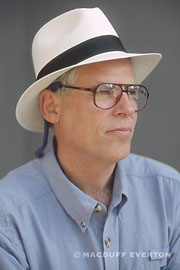 |
Macduff Everton gives a sense of place, whether portraits of individuals or of a landscape. At 17 he took off with his surfboard to Europe, and ended up hitchhiking around the world. He literally picked up a camera when an American took his off, exclaiming that he didn’t want to look like a tourist any longer. When he reached Japan he sold his first stories, one on Burma, the other on Southeast Asia. Returning to the United States at 19, he was hired by an educational film company to travel to Latin America to create college-level archaeological and anthropological filmstrips. When the company ran out of money, he returned to Yucatán and began documenting the living Maya, a culture in transition. In order to support his project he took a number of seasonal jobs that included wrangler, muleskinner, and white water river guide. Rural living honed his skills of observation and appreciation of light and weather. He would spend six months in the backcountry, then return to Yucatán, and later, the University of California where he earned an MFA. In 2012 the University of Texas Press published The Modern Maya Incidents of Travel and Friendship in Yucatán. There aren't many documentary photography projects that span more than forty years, especially working with the same families. The book is their stories. While most history chronicles the famous, this book is about the lives of ordinary people who are the soul of their culture. History only exists if someone documents it. |
|
He is a contributing editor at National Geographic Traveler, and his many editorial clients include Condé Nast Traveler, Gourmet, House & Garden, Life, National Geographic Traveler, LA Times Magazine, NY Times Magazine, Outside, Smithsonian, and Town & Country. An early champion of his work, Andy Grundberg wrote, "Macduff Everton updates travel photography in the same way that Ansel Adams updated 19th century photography of the West. He captures strange and eloquent moments in which time, and the world, seem to stand still." His work is in the collections of many public and private institutions, including the Bibliotheque Nationale, Paris; Brooklyn Museum, New York; British Museum, London; International Center of Photography, New York; Los Angeles County Museum of Art, Los Angeles, CA; Musée de L'Elysée, Lausanne, Switzerland; Museo de Arte Moderno, Mexico City, Mexico; Museum of Modern Art, New York; and New York Public Library, New York. Everton exhibits his photos nationally and internationally. He is represented by Janet Borden, Inc., (www.janetbordeninc.com) 560 Broadway, NYC (212.431.0166) and by Kathleen Ewing Gallery (www.kathleenewinggallery.com) in Washington D.C. He has collaborated on several archaeological books including, The Code of Kings The Language of Seven Sacred Temples & Tombs with archaeologists/epigraphers Linda Schele, Peter Matthews and Justin Kerr. Macduff often teams up with his wife, Mary Heebner, an abstract painter and writer. Their two very different visions of a place often inform each other's work. They collaborated on the classic The Western Horizon (Abrams, 2000) and Patagonia, La Última Esperanza (distributed by University of Texas Press). |
||